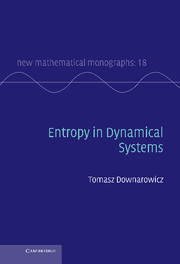Book contents
- Frontmatter
- Contents
- Preface
- Introduction
- PART I Entropy in ergodic theory
- PART II Entropy in topological dynamics
- 6 Topological entropy
- 7 Dynamics in dimension zero
- 8 The entropy structure
- 9 Symbolic extensions
- 10 A touch of smooth dynamics*
- PART III Entropy theory for operators
- Appendix A Toolbox
- Appendix B Conditional S–M–B
- List of symbols
- References
- Index
7 - Dynamics in dimension zero
from PART II - Entropy in topological dynamics
Published online by Cambridge University Press: 07 October 2011
- Frontmatter
- Contents
- Preface
- Introduction
- PART I Entropy in ergodic theory
- PART II Entropy in topological dynamics
- 6 Topological entropy
- 7 Dynamics in dimension zero
- 8 The entropy structure
- 9 Symbolic extensions
- 10 A touch of smooth dynamics*
- PART III Entropy theory for operators
- Appendix A Toolbox
- Appendix B Conditional S–M–B
- List of symbols
- References
- Index
Summary
Zero-dimensional dynamical systems
Due to the existence of arbitrarily fine covers which are at the same time partitions (by disjoint open sets – we call them “clopen covers”), zero-dimensional dynamical systems allow us to switch between the topological and measuretheoretic dynamical notions easier than any other systems.
In order to understand zero-dimensional dynamical systems it suffices to understand subshifts and their countable joinings.
Definition 7.1.1 By a subshift we mean a topological dynamical system (X, T, S), where X is a closed, shift-invariant subset of ∧S′, ∧ is a finite set (called alphabet), and T denotes the shift map σ restricted to X. Both S′ and S stand for either ℕ0 or ℤ but we require that S ⊂ S′. Shift-invariance of X is understood as σ(X) ⊂ X or σ(X) = X, depending on whether S = ℕ0 or ℤ, respectively.
Note that S′ = ℤ implies that T is injective.
Definition 7.1.2 By a symbolic array system we will mean a topological dynamical system (X, T, S), where X consists of symbolic arrays of the form x = (xk,n)k∈ℕ,n∈S′ (S ⊂ S′ like for subshifts), where for each k, n, xk,n belongs to a finite set ∧k not depending on n or x ∈ X, called the alphabet in row k. The transformation T is the restriction to X of the left shift map on arrays
The above definition implicitly requires that X be closed and invariant under T (recall that the meaning of invariance depends on S).
- Type
- Chapter
- Information
- Entropy in Dynamical Systems , pp. 201 - 226Publisher: Cambridge University PressPrint publication year: 2011



